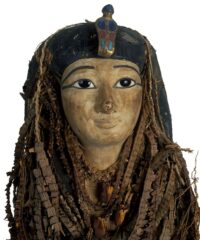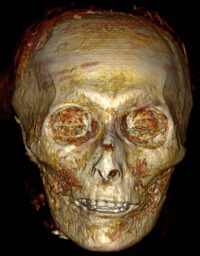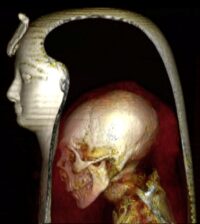 The mummy of Pharaoh Amenhotep I is a unique survivor of the destructive fashion for unwrapping mummies in the late 19th and early 20th century. It has managed to survive the 140 years since its discovery untampered with, thanks largely to the pristine beauty of its wrapping, complete with floral garlands and lifelike wood and cartonnage face mask. It is still pristine, but now thanks to CT scanning, the mummy of Amenhotep I has been unwrapped virtually.
The mummy of Pharaoh Amenhotep I is a unique survivor of the destructive fashion for unwrapping mummies in the late 19th and early 20th century. It has managed to survive the 140 years since its discovery untampered with, thanks largely to the pristine beauty of its wrapping, complete with floral garlands and lifelike wood and cartonnage face mask. It is still pristine, but now thanks to CT scanning, the mummy of Amenhotep I has been unwrapped virtually.
Amenhotep I was the second pharaoh of the 18th Dynasty, who ruled Egypt for two decades, from ca. 1524 to 1504 B.C. His original tomb has never been found, but his mummy was discovered in 1881 at the Deir el-Bahari Royal Cache in Luxor, hidden by priests of the 21st Dynasty to protect royal mummies from being damaged or destroyed by tomb raiders. The mummy was found in a wood coffin inscribed with the pharaoh’s name and recording that Amenhotep I had been rewrapped twice by 21st Dynasty priests of Amun. The pristine wrapping, therefore, was not original to his burial, but a later restoration dating to his reburial in the Royal Cache.
(Three thousand years later, Gaston Maspero, noted French Egyptologist and director-general of the antiquities of Egypt from 1881 until 1914, took over where the priests of Amun had left off. In his dogged pursuit of antiquities traffickers, he arrested the men who had secretly found the Deir el-Bahari cache of royal mummies and they confessed to their find under torture. Maspero quickly had the mummies moved to Cairo to protect them from tomb raiders. He was also responsible for the decision to keep Amenhotep I’s exceptional wrapping intact.)
 The mummy was X-rayed in the 1930s and again in the 1960s, but the technology wasn’t refined enough to provide much in the way of information about the pharaoh’s body. CT scans allowed the creation of a 3D model that can be visualized in its different compositional layers.
The mummy was X-rayed in the 1930s and again in the 1960s, but the technology wasn’t refined enough to provide much in the way of information about the pharaoh’s body. CT scans allowed the creation of a 3D model that can be visualized in its different compositional layers.
“This fact that Amenhotep I’s mummy had never been unwrapped in modern times gave us a unique opportunity: not just to study how he had originally been mummified and buried, but also how he had been treated and reburied twice, centuries after his death, by High Priests of Amun,” said Dr. Sahar Saleem, professor of radiology at the Faculty of Medicine at Cairo University and the radiologist of the Egyptian Mummy Project, the study’s first author. […]
We show that Amenhotep I was approximately 35 years old when he died. He was approximately 169cm tall, circumcized, and had good teeth. Within his wrappings, he wore 30 amulets and a unique golden girdle with gold beads.”
“Amenhotep I seems to have physically resembled his father: he had a narrow chin, a small narrow nose, curly hair, and mildly protruding upper teeth.”
Saleem continued: “We couldn’t find any wounds or disfigurement due to disease to justify the cause of death, except numerous mutiliations post mortem, presumably by grave robbers after his first burial. His entrails had been removed by the first mummifiers, but not his brain or heart.”
 The scans also revealed that contrary to previous scholarship (including Saleem’s), the 21st Dynasty priests had carefully repaired mummies damaged by looters at the end of the 20th Dynasty, not used them as mines of prestige funerary materials. All of Amenhotep’s jewelry and amulets were preserved in the linen wrapping.
The scans also revealed that contrary to previous scholarship (including Saleem’s), the 21st Dynasty priests had carefully repaired mummies damaged by looters at the end of the 20th Dynasty, not used them as mines of prestige funerary materials. All of Amenhotep’s jewelry and amulets were preserved in the linen wrapping.
The research has been published in the journal Frontiers in Medicine and can be read in its entirety here.
Strange the the outer coffin shows him as male but the mummy mask as female. Skin color conventions being the give away.
What are the long dreadlocks made of?
I think they are garlands of fragrant leaves stitched together with some floral attachments. Never seen them done this way before on a mummy.
Ok, I’m confused. The third photo shows a skeleton. How can it possibly be known that he was circumcised … had curly hair???
OK, I did no proper check on Amenhotep I’s royal (maybe not so) circumcised bit, but the picture from the article –i.e. the one linked right next to the “third photo”– clearly shows that he has indeed thin curly hair. Plus, it also comments on the floral arrangement.